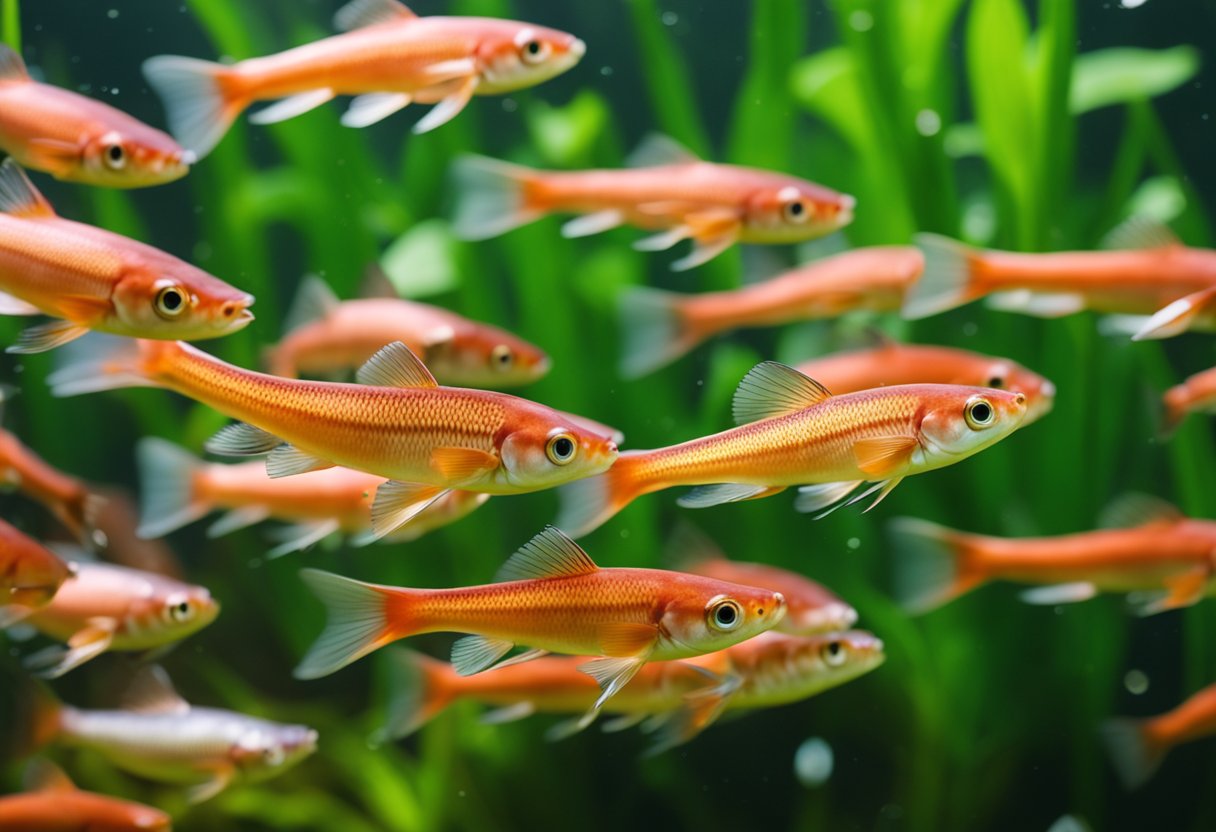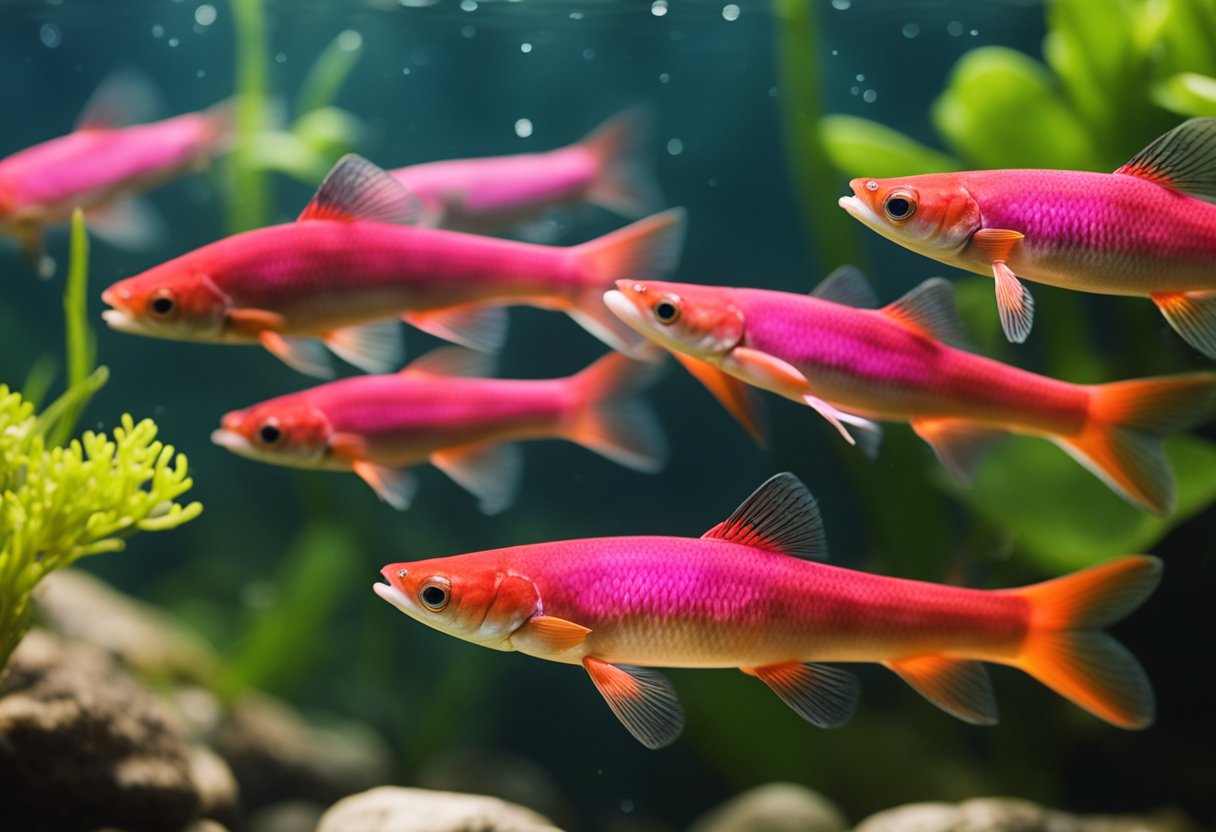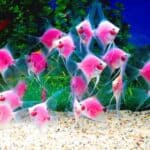Rosy Red Minnows are a freshwater fish species native to North America. They have a broad distribution, found from Canada through the United States and into Mexico. What makes these fish particularly interesting to both amateur and seasoned aquarists is their remarkable resilience, which allows them to thrive in a wide range of environmental conditions. Typically a variant of the Fathead Minnow, the Rosy Red Minnow’s coloration is what sets it apart, with hues ranging from a subtle pink to a bright orange.

In their natural habitat, these minnows are able to adapt to various water conditions, often encountered in slow-flowing rivers, streams, ponds, and lakes. Their physical characteristics are modest, with adults reaching an average size that makes them suitable for smaller aquariums. The fish have a peaceful demeanor, tend to display schooling behavior, and can be a pleasant addition to a community tank. Due to their ease of care and robust nature, Rosy Red Minnows are also commonly utilized as feeder fish.
Key Takeaways
- Rosy Red Minnows adjust well to a range of aquarium conditions thanks to their hardy nature.
- They exhibit a schooling behavior, making them a peaceful addition to community tanks.
- With their simple care requirements and efficient breeding, these minnows are good for both novice and experienced fishkeepers.
Natural Habitat

In this section, we explore the Rosy Red Minnow’s native environments, examining where they thrive and the water conditions they prefer.
Geographical Distribution
Rosy Red Minnows, Pimephales promelas, are native to freshwater bodies throughout North America. Their range extends from the northern regions of Canada to the southern edges of Mexico. These fish are not restricted to a narrow habitat range due to their adaptability.
Water Conditions
In their natural habitat, Rosy Red Minnows are accustomed to a variety of water conditions. They are found in:
- Lakes
- Ponds
- Streams and rivers
The pH levels in these waters typically range from slightly acidic to slightly alkaline, and the temperatures vary widely, reflecting the seasonal changes across their diverse habitats.
Environmental Preferences
Rosy Red Minnows prefer clustered vegetation and a substratum that offers hiding spots, such as rocks or submerged logs. In these environments, they find shelter and breeding grounds, demonstrating a preference for:
- Areas with moderate current
- Accessible surface cover
Their adaptability allows them to thrive in various conditions, including environments that may be inhospitable to more sensitive species.
Physical Characteristics

Rosy Red Minnows exhibit distinct physical features that make them easy to identify and a favorite among aquarium enthusiasts. Our focus lies on their color variations and their size and anatomy.
Color Variations
Rosy Red Minnows are a color morph of the fathead minnow (Pimephales promelas). Their typical coloration is a vibrant pinkish-orange hue, which is not found in their wild-type counterparts that display a more olive-gray shading. It’s important to note that despite the name, not all individuals exhibit a uniform rosy red; some can have paler shades.
Size and Anatomy
Regarding their size, Rosy Red Minnows are small fish. Adult lengths commonly reach up to 3 inches (7.6 cm). They have a plump, laterally compressed body with a relatively small head and blunt snout. Our description of their anatomy would not be complete without mentioning their dorsal fin, which is positioned far back near their rounded tail fin, a characteristic feature of this species.
Behavior and Life Cycle

In our exploration of Rosy Red Minnows, we focus on their distinct social behavior, intricate reproduction process, and the clear stages of growth they experience throughout their lifecycle.
Social Behavior
Rosy Red Minnows are gregarious by nature, preferring the company of their kind. We find them swimming in schools which helps with defense against predators. In a tank setting, it’s vital to keep them in groups to ensure they exhibit natural behavior and reduce stress.
Reproduction
The breeding process begins with the male choosing and cleaning a spot for the female to lay eggs. Nuptial tubercles on the male’s head and body help protect the eggs, which the male then guards post-fertilization. A female Rosy Red Minnow can lay hundreds of eggs at once, which usually hatch within five days.
Growth Stages
Rosy Red Minnows have a clear pattern of development:
- Egg Stage: After the eggs are laid and fertilized, they hatch within 4-5 days.
- Larval Stage: Following hatching, they enter the larval stage, remaining stationary as they absorb their yolk sacs.
- Juvenile Stage: Once they begin to swim and feed independently, they are considered juveniles.
- Adult Stage: They reach adulthood in about 1-2 years, continuing the cycle of the species.
Aquarium Care
In keeping Rosy Red Minnows, we focus on creating a stable environment that meets their specific needs. Each aspect of aquarium care—tank setup, feeding requirements, and health management—is vital to ensure the well-being of these hardy fish.
Tank Setup
The ideal tank setup for Rosy Red Minnows should mimic their natural habitat. We recommend:
- Tank Size: Start with at least a 10-gallon tank to give them enough space to swim.
- Water Parameters: Maintain a temperature range of 64-78°F and a pH between 6.5 and 8. A moderate water hardness is suitable for them.
- Filtration: Use a filter with an adjustable flow rate—Rosy Red Minnows prefer a mild current.
- Decoration: Include ample hiding spots like caves and plants; live plants also help with water quality.
Feeding Requirements
Rosy Red Minnows thrive on a varied diet. We ensure that:
- Diet Composition: Their diet includes high-quality flake food, frozen or live brine shrimp, and bloodworms for protein.
- Feeding Schedule: We feed them small amounts once or twice a day, being careful not to overfeed.
Health Management
To manage the health of Rosy Red Minnows, we keep an eye on:
- Water Quality: Regularly test the water for ammonia, nitrite, and nitrate levels to prevent toxic buildup.
- Disease Prevention: Quarantine new fish before adding them to the tank and watch out for signs of illness, such as lethargy or loss of appetite.
Breeding Techniques
In our experience, successful breeding of Rosy Red Minnows involves a thorough selection of healthy breeders, the replication of optimal spawning conditions, and careful rearing of fry.
Selecting Breeders
We must first ensure that the breeders are healthy and exhibit the characteristics that we aim to replicate in the offspring. It is ideal to choose males with bright coloration and pronounced tubercles (breeding bumps) and females that are larger and fuller-bodied, indicating readiness to spawn.
Spawning Conditions
To encourage spawning, we closely mimic the natural environment of Rosy Red Minnows. A breeding tank with soft to hard water, pH between 6 and 8, and a temperature range from 70-78°F (21-26°C) is vital. We provide flat surfaces or overhangs for egg deposition and maintain optimal water quality.
Rearing Fry
Once eggs are laid, they typically hatch within five days. We immediately provide an abundance of food sources like infusoria or liquid fry food, transitioning to baby brine shrimp as they grow. Keeping the tank clean and maintaining stable water conditions is crucial for the survival rate of the fry.
Frequently Asked Questions
We’ve gathered the most common inquiries about Rosy Red Minnows to help address them with clear and concise information.
What is the ideal tank size for Rosy Red Minnows?
A 10-gallon tank is suitable for a small group of Rosy Red Minnows, allowing enough space for comfortable swimming and group dynamics.
What is the diet of Rosy Red Minnows?
Rosy Red Minnows are omnivores and can be fed a varied diet consisting of flakes, pellets, and live or frozen foods such as daphnia or brine shrimp to maintain their health.
How fast do Rosy Red Minnows grow?
Rosy Red Minnows grow quickly during their first few months of life, reaching maturity around three to four months of age.
What are some suitable tank mates for Rosy Red Minnows?
They can coexist with non-aggressive fish of a similar size, making good companions for species like guppies, mollies, and tetras.
Can Rosy Red Minnows thrive in outdoor ponds?
Yes, Rosy Red Minnows can adapt well to outdoor ponds and are resilient throughout various conditions, including temperature fluctuations.
Do Rosy Red Minnows contribute to controlling mosquito populations?
Rosy Red Minnows eat mosquito larvae, hence adding them to your pond can help manage and reduce mosquito populations.






